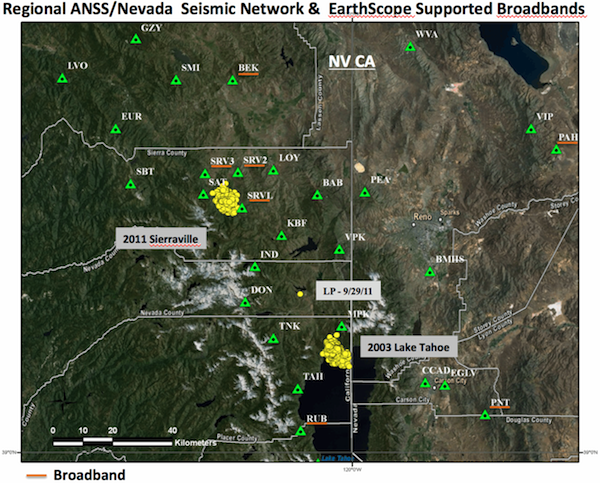2012 IRIS Workshop
Moho-Depth Diking and Rifting of the Sierra Nevada Microplate
Kenneth Smith: NSL-University of Nevada Reno, David von Seggern: NSL-University of Nevada Reno, Graham Kent: NSL-University of Nevada Reno: Amy Eisses, NSL-University of Nevada Reno, Neal Dri:
Map view of the 2003 N. Lake Tahoe and 2011 Sierra Valley, California Moho-depth sequences. Also shown is the location of a Long-Period event on 9/27/2011 at a depth of 30 km. Included are seismograph stations of the ANSS N. California network operated by the Nevada Seismological Laboratory and broadbands installed with NSF support in the near source area of the Sierraville sequence.

Full-resolution graphics file in original format: 0074.gif
A swarm of deep (29-34 km) low magnitude earthquakes began in August 2011 near Sierraville (SV), California and has continued through March 2012. Of the 2235 events located to date the largest has been M 1.9. The swarm has nearly all of the characteristics of a deep sequence under N. Lake Tahoe in 2003, about 45 km to the SE. Both are interpreted as dike injection events into a strong ~5 km thick upper-mantle layer. NSF-Earthscope is supporting near source broadband instruments to supplement the local ANSS network. Each sequence aligns along, and defines, a N45W striking 50-degree northeast dipping Moho-depth structure. The uppers extent of the SV sequence is about 5 km deeper than the shallowest events of 2003 N. Tahoe swarm, implying an ~10% gradient in Moho depth between Tahoe and SV (assuming the shallowest events define the base of the crust). Additionally, the first Long-Period event identified along the northeastern Sierra (9/27/2011) lies on the interpreted structure at depth, yet is not spatially associated with either sequence. GPS velocities, relative to stable NA, are parallel to the strike of the structure and models show relatively high extensional strain near SV (Kreemer et al, 2009). We interpret the processes as rifting of the Sierra Nevada microplate; extension and decompression melting/diking weaken and rupture a strong Moho-depth layer. Both the 2003-04 and 2011-12 sequences were associated with increased upper-crustal seismicity suggesting pronounced strain events. The structure imaged by near-Moho depth earthquakes provides insights into the uplift of the northern Sierra and the evolution of the northern Walker Lane.
Acknoweldgements: Monitoring a Deep Earthquake Sequence, Sierraville, CA, northern Sierran Nevada; NSF EarthScope Rapid Grant #: EAR-1202664. NEHRP USGS ANSS Western Great Basin Seismic Network: Grant #: G10AC00090
For further reading: 1. Smith, K.D, von Seggern D.P., Kent, G.M., Eissis, A., and Driscoll, N.W. (2012). Moho-Ddpth diking and structural controls on microplate rifting mechanisms along the northern Sierra Nevada – Walker Lane Bounday, Seism. Res. Lett. 82, March/April 2012. 2. Smith, K.D., von Seggern, D, Blewitt, G, Anderson, J, Preston, L, Wernicke, B, Davis, J, (2004). Evidence for deep magma injection Lake Tahoe, Nevada-California, Science v. 305, 1277-1280.
Keywords: volcanic_swarms, deep_earthquakes, continental_rifting, basin_and_range, walker_lane
